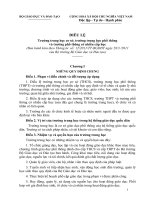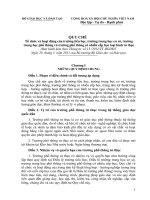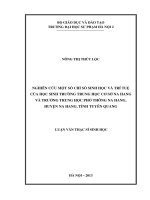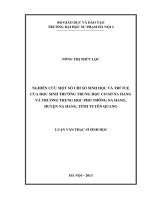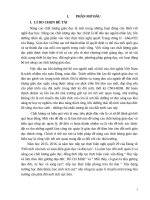Tiêu chuẩn đánh giá hiệu trưởng các trường trung học cơ sở tại thành phố hải phòng cơ sở xây dựng chương trình chiến lược
Bạn đang xem bản rút gọn của tài liệu. Xem và tải ngay bản đầy đủ của tài liệu tại đây (2.01 MB, 135 trang )
ASSESSMENT OF THE LEADERSHIP STANDARDS OF THE
SECONDARY SCHOOL LEADERS IN HAI PHONG CITY:
BASIS FOR AN INTERVENTION PROGRAM
A Dissertation Presented To
The Faculty of the Graduate School
Southern Luzon State University, the Philippines
In Collaboration with Thai Nguyen University
Socialist Republic of Vietnam
In Partial Fulfillment of the
Requirements for the Degree
Doctor of Philosophy In Educational Management
NGUYEN THI DAT KHOA - (LUCY)
April 2014
APPROVAL SHEET
In partial fulfillment of the requirements for the degree Doctor of Philosophy in
Educational Management, this research entitled “Assessment of the Leadership Standards
of the Secondary School Leaders in Hai Phong City: Basis for an Intervention Program”
has been prepared and submitted by Nguyen Thi Dat Khoa (Lucy) and is hereby
recommended for oral examination.
___________________________________
DR. RICARYL CATHERINE P. CRUZ
Research Adviser
Approved by the Oral Examination Committee, in partial fulfillment of the
requirements for the degree Doctor of Philosophy in Educational Management offered by
Southern Luzon State University, Republic of the Philippines in collaboration with Thai
Nguyen University, Socialist Republic of Vietnam.
__________________________
Member
____________________________
Chairman
_____________________________
Member
DR. SUSANA A. SALVACION
Dean, Graduate School
Accepted in partial fulfillment of the requirements for the degree Doctor of
Philosophy in Educational Management offered by Southern Luzon State University,
Republic of the Philippines in collaboration with Thai Nguyen University, Socialist Republic
of Vietnam.
____________
Date
DR. WALBERTO A. MACARAAN
Vice President for Academic Afairs
ii
ACKNOWLEDGMENTS
Writing a doctoral dissertation is a gratifying but difficult and sometimes nerve wrecking
endeavor that only few engaged in because it requires a lot of sacrifices and hard work from the
researcher. However, at the end of the task, one experiences a wonderful feeling of joy, happiness,
relief and fulfillment.
The researcher would like to extend her sincerest gratitude and thanks to the following people
who were very instrumental in the fulfillment of this research.
DR. CECILIA N. GASCON, President of the Southern Luzon State University in the
Republic of the Philippines, for her untiring effort and belief that this collaboration is possible thus
enabling her to pursue the Doctor of Philosophy in Educational Management;
DR. DANG KIM VUI, President of Thai Nguyen in the Socialist Republic of Vietnam, for
his untiring effort and belief that this collaboration is worthy for implementation;
DR. NGUYEN THE HUNG, Director of the International Training Center, Thai Nguyen
University of the Socialist Republic of Vietnam, for his significant concern to provide the Vietnamese
people an opportunity to grow through education;
DR. RICARYL CATHERINE P. CRUZ, her adviser, for the guidance and endless support
for the improvement of this study.
DR. APOLONIA A. ESPINOSA, DR. WALBERTO A. MACARAAN, DR. BELLA R.
MUELLO, and DR. TERESITA V. DE LA CRUZ who composed the Oral Defense Committee, for
their suggestions, comments and corrections to improve this study;
ITC STAFF, for providing the necessary research materials;
HER FAMILY and FRIENDS, for the love and support in one way or the other;
And TO ALL who have contributed to make this study a success.
iii
TABLE OF CONTENTS
Title Page
Page
APPROVAL SHEET ..........................................................................................
ii
ACKNOWLEDGMENT .....................................................................................
iii
TABLE OF CONTENTS ....................................................................................
iv
LIST OF TABLES ..............................................................................................
vi
LIST OF FIGURES ............................................................................................
viii
LIST OF APPENDICES .....................................................................................
ix
ABSTRACT ................................................................................................
x
Chapter I. INTRODUCTION
1
Background of the Study ........................................................
3
Objectives of the Study ............................................................
7
Hypothesis ................................................................................
8
Significance of the Study .........................................................
8
Scope and Limitation of the Study .....................................
9
Definition of Terms ................................................................
9
Chapter II. REVIEW OF RELATED LITERATURE
12
AND STUDIES
Related Literature and Study ...............................................
12
Conceptual Framework ............................................................
29
Research Paradigm ...................................................................
31
iv
Chapter III. RESEARCH METHODOLOGY
32
Locale of the Study ..................................................................
32
Research Design .......................................................................
32
Respondents of the Study .........................................................
32
Instrumentation ........................................................................
33
Data Gathering Procedure .......................................................
34
Statistical Treatment ................................................................
34
Chapter IV. RESULTS AND DISCUSSION
38
Profile of respondents ..............................................................
38
Perception of the Respondents on the Current Leadership
Standards of the Secondary School Leaders in Hai Phong
City ...........................................................................................
46
Perception of the Respondents on the Current Leadership
Standards of the Secondary School Leaders in Hai Phong
City .....................................................................
55
Proposed Intervention Program
68
Chapter V. SUMMARY, CONCLUSIONS AND
RECOMMENDATIONS
76
Summary ...............................................................................
76
Findings ................................................................................
76
Conclusions ...........................................................................
78
Recommendations .....................................................................
79
BIBLIOGRAPHY
80
APPENDICES
83
CURRICULUM VITAE
123
v
LIST OF TABLES
Table
Page
1
Scale of values . . . . . . . . . . . . . . . . . . . . . . . . . . . . . . . . . . . . . . . . . . . .
34
2
Frequency and Percentage Distribution of the Respondents' Profile in
Terms of Age . . . . . . . . . . . . . . . . . . . . . . . . . . . . . . . . . . . . . . . . . . . . .
38
Frequency and Percentage Distribution of the Respondents' Profile in
Terms of Gender . . . . . . . . . . . . . . . . . . . . . . . . . . . . . . . . . . . . . . . . . .
39
Frequency and Percentage Distribution of the Respondents' Profile in
Terms of Civil Status . . . . . . . . . . . . . . . . . . . . . . . . . . . . . . . . . . . . . .
39
Frequency and Percentage Distribution of the Respondents' Profile in
Terms of Educational Attainment . . . . . . . . . . . . . . . . . . . . . . . . . . . . .
40
Frequency and Percentage Distribution of the Respondents' Profile in
Terms of Monthly Income . . . . . . . . . . . . . . . . . . . . . . . . . . . . . . . . . . .
42
Frequency and Percentage Distribution of the Respondents' Profile in
Terms of Length of Service . . . . . . . . . . . . . . . . . . . . . . . . . . . . . . . . . .
43
Frequency and Percentage Distribution of the Respondents' Profile in
Terms of Length of Management Experience . . . . . . . . . . . . . . . . . . . .
43
Mean Distribution of the Responses on the Leadership Standards of the
Secondary School Leaders in Hai Phong City in terms of
Shared Vision. . . . . . . . . . . . . . . . . . . . . . . . . . . . . . . . . . . . . . . . . . . . .
46
10 Mean Distribution of the Responses on the Leadership Standards of the
Secondary School Leaders in Hai Phong City in Terms of Culture
of Learning . . . . . . . . . . . . . . . . . . . . . . . . . . . . . . . . . . . . . . . . . . . . . . .
48
11 Mean Distribution of Responses on the Leadership Standards of the
Secondary School Leaders in Hai Phong City in Terms of
Management . . . . . . . . . . . . . . . . . . . . . . . . . . . . . . . . . . . . . . . . . . . . . .
49
12 Mean Distribution of the Responses on the Leadership Standards of
the Secondary School Leaders in Hai Phong City in Terms of
Family and Community . . . . . . . . . . . . . . . . . . . . . . . . . . . . . . . . . . . . . .
51
13 Mean Distribution of the Responses on the Leadership Standards of the
Secondary School Leaders in Hai Phong City in Terms of Ethics . . . . . .
52
14 Mean Distribution of the Responses on the Leadership Standards
of the Secondary School Leaders in Haiphong City in Terms of
Societal Context . . . . . . . . . . . . . . . . . . . . . . . . . . . . . . . . . . . . . . . . . . . . .
54
15. Correlation of the Responses on Shared vision with profile of Respondent
55
3
4
5
6
7
8
9
vi
16. Correlation of the Responses on Culture of Learning with profile of Respondent
57
17. Correlation of the Responses on Management with profile of Respondent
60
18. Correlation of the Responses on Family and Community
with profile of Respondent
62
19. Correlation of the Responses on Ethics with profile of Respondent
64
20. Correlation of the Responses on Societal Context with profile of Respondent
66
vii
LIST OF FIGURES
Figure
Page
1. Input-Process-Output on the Perceived Leadership Standards
Of the Secondary School Leaders: Basis for an Intervention
31
2. Administrative Map of Hai Phong City
37
viii
LIST OF APPENDICES
Appendix
Page
A
Letter to Respondents and Questionnaire
83
B
Raw Data
91
C
Weighted mean for Gender, age in leadership standards of
Shared Vision; Culture of Learning; Management; Family
and Community; Ethics; and Societal Context.
99
D
E
F
Weighted mean Monthly income, Civil status, Education
attainment in leadership standards of Shared Vision; Culture
of Learning; Management; Family and Community; Ethics;
and Societal Context.
100
Weighted mean for Length of service, Length of management
experiences in leadership standards of Shared Vision; Culture
of Learning; Management; Family and Community; Ethics; and
Societal Context.
101
Chi – Square Analysis between Share vision and Profile
of the principal asked
102
ix
Title:
ASSESSMENT OF THE LEADERSHIP STANDARDS OF
THE SECONDARY SCHOOL LEADERS IN HAI PHONG
CITY: BASIS FOR AN INTERVENTION PROGRAM
Researcher:
NGUYEN THI DAT KHOA – LUCY
Degree
Doctor of Philosophy, Educational Management
Nam/ Address of the Southern Luzon State University
Institution
Graduate School
Lucban, Quezon
Date Completed
April 2014
Adviser
DR. RICARYL CATHERINE P. CRUZ
ABSTRACT
The primary intent of this study was an assessment of the leadership standards of the
secondary school leaders in Hai Phong City, as a basis for intervention program. The
leadership standards of the secondary school leaders essential for analysis are shared vision,
culture of learning, management, family and community, ethics, and societal context.
This includes the perception of the respondents on the current leadership standards of the
secondary school leaders in Hai Phong City; determine the problems encountered in the
current leadership standards of the secondary school leaders; ascertain the significant
difference on the problems encountered when the respondents are grouped according to their
profile and propose an intervention program to enhance the leadership standard of the
secondary school leaders in Haiphong City. This study used correlation in analyzing the
variables. Measurement of the leadership standards of the secondary school leaders is limited
from the questionnaire. The questionnaire was used as a major data-gathering instrument and
the unstructured interview was done to cross check the responses of the respondents. There
x
were 203 leaders (principals/headmasters) used as respondents in the study. The weighted
mean and the Chi - Square value analysis were used to analyze the data. In the evaluation
based on the criteria of leaders, the secondary-school principals in Hai Phong have been good
in reviewing the content in general. However, some specific works considered could not have
been well-done. For instance: in utilizing researches and/or best practices in improving the
educational program aligning and implementing the educational programs, plans, actions, and
resources with the district's vision and goals; providing leadership for assessing, developing
and improving climate and culture; evaluating staff and providing ongoing coaching for
improvement; articulating the desired school culture and showing evidence about how it is
reinforced; recruiting, selecting, inducting, and retraining staff to support quality instruction;
managing fiscal and physical resources responsibly, efficiently, and effectively; proving and
demonstrating appreciation and sensitivity to diversity in the school community; implement
appropriate strategies to reach the desired goals. With this, the study has offered improvement
of the quality and efficiency of the principals’ activities, aiming primarily on the weak
contents focusing on the following issues: management of administrators, teachers, and staff;
management of finance and facilities; implementation of the principal evaluation. It is
therefore recommended that the principals with their concerted efforts enrich the teacher
characteristics so as to arm them better for a positive learning climate, improve their
technology adeptness’ and that could enhance students’ motivation and self-regulation.
xi
Chapter 1
INTRODUCTION
Education is the key to sustain development in Vietnam. Education is an indispensable
means for socio-economic development of the country in the cause of industrialization and
modernization. The Party and the State always considered education as a top national policy.
To develop education, educational management plays a key role to determine the quality and
effectiveness of the educational activities.
Haiphong port city is the first center urban type of national level which has an important
position in the socio- economic and security and defense of the northern regions of the
country. Haiphong has natural area of 1519.2 km2, population of 1842.8 thousand people and
15 administrative divisions. Haiphong (7 urban districts and 8 suburban districts) – a key
economic center of the northern region with enormous potentiality.
XIVth Party Congress Resolution city has identified development goals of the city in
2015, which is: "To promote comprehensive, the potential advantages of the port city, focus
all resources to promote the process of industrialization, modernization and international
integration, to create a breakthrough development of Haiphong in 2015, a city to become an
industrial port services towards civilization, the university; rapid economic development and
sustainability; urban development deserve the grade I-national urban centers; cultural
development is the spiritual foundation of society; defense-enhanced security; leadership, the
political, the battle of the whole Party and the effectiveness and efficiency of the political
system continues to be improved; ensure progress, justice, social security; continue to
improve and enhance the quality of life of the people. "
The reality of Vietnamese secondary education shows that the educational managers are
the ones who lead and manage the overall educational activities at school. This is the all over
educational process with the goals of developing over ally the junior secondary students (year
1
6 - year 9 classes) in the direction of forming and enhancing the students’ morality, and
broadening the educational scale in a reasonable way.
However, in the process of managing the schools, the managers cannot change the
school activities themselves because one of the facets of management is the implementation
of every activity which can only be done by the efforts of the other people. If the managers
would like the staffs to participate in the process, the managers have to make them become
aware of the policies and accept them. For a school, the teachers and staffs are the ones who
support and create the potential for the head masters to carry out the changes if they are the
right ones. It is believed that the teachers and staffs are the people who play the decisive roles
for the school successes.
If they would like to renovate the educational system to meet the needs of the society,
each school has to train and educate the teachers and staffs to become highly qualified ones,
who have good political value, good morality, and endless love with the children and the
teaching profession. Therefore, one of the heaviest duties of the educational managers is to
build up a strong force of teachers and staffs for the schools.
So, it is for sure that, if a school would like to increase the quality of education, the first
thing it must have is a highly qualified managers, who have good morality, knowledge and
skills to lead the school. The managers have to build up a suitable system of managerial
policies on the foundation of the good relationship between the school, community and
students’ families. This can be a firm foundation for him/her to form his/her strategic plans.
In order to achieve those goals, the educational and training programs of Haiphong city
need to have the important change. The city has to set up its close administration on education
with the first work of building up a strong educational management. It is now an urgent work
for the researcher to help the city leaders to find out the best policies to train the good head
masters, and to evaluate and manage them. This can be a good foundation for the city to
create the strategic plan to develop the education of the city.
2
Background of the Study
The Vietnamese inherited a high respect for learning. Under Confucianism, education
was essential for admission to the ruling class of scholar-officials, the Mandarinate Under
French rule, even though Vietnamese were excluded from the colonial power elite, education
was a requisite for employment in the colonial civil service and for other white-collar, highstatus jobs. In divided Vietnam, education has continued to be a channel for social mobility in
both the North and the South.
Before the 1950s, poverty was a major impediment to learning, and secondary and
higher education were beyond the reach of all but only a small number of upper class people.
Subsequently, however, rival regimes in Hanoi and Saigon broadened educational
opportunities. Both governments accomplished this despite the shortage of teachers,
textbooks, equipment, and classrooms, as gravitated by the disruptions of war in the 1960s
and the early 1970s. The school system was originally patterned after the French model, but
the curriculum was revised to give more emphasis to Vietnamese history, language, and
literature and, in Hanoi, to the teaching of revolutionary ethics and Marxism-Leninism.
( />In Vietnam, children enjoyed 12 years of basic education on a half-day basis before they
moved on to college or university or began to work. Education played a central role in
Vietnam. Not only was the devotion to study one of society’s core values, but education was,
of course, also perceived as a chance of advancement. There were huge education needs for
Vietnam’s young ones, and the public school system could not always satisfy them. In
general, families invested a lot of time and money to send their children to a good school and
ensured
they
would
have
a
bright
future.
( />
expats/guide/living-in-vietnam-15470/education-in-vietnam-3).
Education had always had a central role in Vietnam culture and society. It was seen as
the avenue of advancement and families routinely sacrifice much to ensure their offspring get
3
the required education. The government of Vietnam had for some time set the priority of
education in terms of its budget. In 2008, the Department of Finance and Planning, MOET
reported that education occupied approximately 20 percent of all state budget expenditures
and accounted for 5.5 percent of GDP. (Christopher Runckel, President of Runckel &
Associates)
Dr. Nguyen Van Trang, Director General of the Secondary Education Department,
Ministry of Education and Training stated in his writing entitled Secondary Education in
Vietnam that “Vietnam's Education Law dated December 11, 1998 had affirmed that the goals
of education were to comprehensively develop Vietnam's human resource, with morality,
knowledge, good health, and loyalty to the idea of national independence and socialism; to
develop individual personality and capacity for the building and protection of the country.
The goals set forth for secondary education are students' all-round development in terms
of morality, physical body, arts, and basic skills so that they could be prepared to pursue
further studies or to become fully responsible citizens contributing to the building of the
country.
There were specific objectives designed for each level within the secondary education.
Basic secondary education strengthened and enhanced students' achievements gained from
lower education, developed their basic knowledge and introduced technical and vocational
skills so that they could follow their future studies at high schools, vocational college or go to
work. High school education further developed students' knowledge after basic secondary
education with vocational orientation so that after graduation, high school students could join
the university programs or vocational colleges or directly go to work. (Oct 12, 2006,
/>Dr. Sharma (2009) stated that “Educational management is a field of study and practice
concerned with the operation of educational organizations, they had consistently argued that
educational management had to be centrally concerned with the purpose or aims of education.
4
These purposes or goals provided the crucial sense of direction to underpin the management
of educational institutions. Unless this link between purpose and management was clear and
close, there was a danger of “managerialism…a stress on procedures at the expense of no
super-ordinate goals or values of its own. The pursuit of efficiency may be the mission
statement and objectives which others define”. (Educational Management: a Unified
Approach of Education, Dr. S.L. Sharma, Global India Publications Pvt Ltd., 2009)
School leadership had become a priority in education policy agenda across OECD and
partner countries. It has played a key role in improving school outcomes by influencing the
motivations and capacities of teachers, as well as the environment in which they worked. At
the interface between classrooms, individual schools and the outside world, school leadership
is essential to improve the efficiency and equity of schooling.
As countries have been seeking to adapt their education systems to the needs of
contemporary society, the expectations for schools and school leaders have changed
profoundly. The role of school leaders has been evolving in response to shifting expectations
for schools and educational policies that stress decentralization, autonomy and accountability,
as well as new understandings of teaching and learning.
Once limited to the functions of bureaucratic administrator or head teacher, school
leadership has now been increasingly defined by a far larger and more demanding set of roles
including financial and human resource management and leadership for learning. In many
countries today, the men and women who have run schools are overburdened, underpaid and
near retirement, whereby there have been only few people lining up for their jobs.
Policymakers needed to adapt school leadership policy to new environment by
addressing the major challenges that had arisen and intensified over the past decades. As
expectations of what school leaders should achieve have been changed, the definition and
distribution of tasks, as well as the levels of training, support and incentives need revision.
(www.oecd.org/edu/schoolleadership)
5
Haiphong was a coastal city in a distance of 102 kilometers to the Northeast of Hanoi
capital, borders with Quang Ninh province to the North, Hai Duong province to the West,
Thai Binh province to the South, and Bac Bo Bay in the East Sea and Hai Nam Island to the
East. The city was located in the “two corridors and one belt” of economic cooperation
between Vietnam and China, and had a significant position in the socio-economic
development, national defense and security of the North and the whole country.
Haiphong, known as the Red Flamboyant City, was the biggest port and industrial city
in the North of Vietnam, located in the Northern delta area. Haiphong was the third largest
city of Vietnam after Ho Chi Minh City and Hanoi capital. Haiphong was one of the five
cities under direct control of the Central Government, the first-rank central city at national
level together with Da Nang and Can Tho. As of December 2011, Haiphong population was
1,907,705 people, of which 46.1% live in urban area while 53.9% in rural area, that made
Haiphong the 3rd crowded city in Vietnam.
Currently, there have been 203 secondary schools in Haiphong City providing education
and training for around 88,976 students. There have been some changes and progress in the
management of education. However, those achievements have not really met the innovation
and development requirements of the society. The education quality in some schools was
somehow low. A number of managers had slow and low innovation, little creativeness,
careful attention and has not developed strategies for the schools. The coordination between
inspection results with professional work, education management and emulation, the
appointment, transfer and use of officials and teachers had not achieved the desired results.
On October 22, 2009, the Minister of Ministry of Education and Training issued the
Circular No. 29/2009/TT-BGDDT regarding the standard system of school leaders of every
primary school and secondary schools. The purposes of this circular were to let the school
leaders self-assess their skills and capacity, to serve as bases for the governing institutions to
6
assess and rank the quality of school leaders before they were trained, promoted and
appointed.
Objectives of the study
The study was aimed to assess the leadership standards of the secondary school leaders
in Haiphong City;
Specifically, it sought to attain the following objectives:
1. Determine the profiles of the respondents as indicated by:
1.1. Age;
1.2. Gender;
1.3. Civil Status;
1.4. Educational Attainment;
1.5. Monthly Income;
1.6. Length of Service;
1.7. Length of Management Experiences.
2. Find out the perception of the respondents on the current leadership standards of the
secondary school leaders in Haiphong City in terms of:
2.1. Shared Vision;
2.2. Culture of Learning:
2.3. Management;
2.4. Family and Community;
2.5. Ethics;
2.6. Societal Context.
3. Ascertain the significant difference on the current leadership standards of the
Secondary School Leaders in Haiphong City when the respondents are grouped according to
their profile.
4. Develop an intervention program based on the results of the study.
7
Hypothesis
There is no significant difference on the leadership standards of the secondary school
leaders when the respondents are grouped according to their profile.
Significance of the Study
Ministry of Education and Training: The results of the study and the proposed
solutions of the Department of Education and Training of Haiphong City can serve as a good
idea for MOET to consider and request the Department of Education and Training of every
Province and City in Vietnam to assess the current status of the leadership standards of the
school leaders in general and the secondary school leaders in particular. Moreover, MOET
could think of possibilities to conduct further studies to design a complete training program to
improve the leadership skills of school leaders.
Department of Education and Training of Haiphong City: The results of the study
might serve as a good basis for the DET to think of possibility to assess the current leadership
standards of the principals of all primary and high schools in Haiphong City. DET could
propose proper solutions to the Ministry of Education and Training for the designing of a
complete training program to improve the leadership skills of school leaders.
Offices of Education and Training: The results of the study and the proposed
solutions may serve as a good recommendation/suggestion for the OET of districts and wards
in Haiphong City to see the status and problems faced by the secondary school leaders in their
area. OETs will then report to DET and request for proper actions.
Secondary school leaders: The results of the study and the proposed solutions by the
researcher helped the school leaders see their strengths, weaknesses and they themselves
thought to adjust the requests for suitable training programs to improve their leadership
standards.
Secondary school teachers: These are the results of the study and the proposed
solutions by the researcher might recommend school leaders methods to improve themselves
8
and once the leadership standards of the school leaders are improved, the secondary school
teachers might be provided with better environments, conditions and chances to teach. The
quality of the teaching would then be improved.
The future researchers: The future researchers who may conduct surveys/study in
their areas in order that they could find results on the current leadership standards as well as
problems faced by the school leaders.
Scope and Limitation of the Study
The study was conducted to assess the current leadership standards of the secondary
school leaders in Haiphong City. A total of 203 leaders (principals) of secondary schools in
Haiphong City were selected as the respondents of the study. It specifically explored on what
solutions could be introduced to deal with the problems there might be and then improve the
leadership standards of the secondary school leaders. The study was limited on the profile of
the respondents in terms of gender, age, monthly income, marital status, educational
attainment, length of service and length of management experiences, as well as the existing
status of the leadership standards of the secondary school leaders in Haiphong City in terms of
shared vision; culture of learning; management; family and community; ethics; and societal
context.
The researcher used the questionnaire based on documents in evaluating the school head
masters of Hai Phong city, especially on the implementation of the Circular No. 29/2009/TTBGDDT of the Minister of Ministry of Education and Training and the standard system of
school leaders of primary school and junior secondary schools.
It was conducted on April
2013.
Definition of terms
The following terms is hereby defined conceptually and operationally for better
understanding and clarification of the study. Below are the terms:
9
Age refers to the age of the respondents when the study has been conducted. Conceptually,
this is the length of time that one has existed; duration of life or One of the stages of
life: (the age of adolescence; at an awkward age.)
Civil status refers to the conjugal status in relation to marriage laws of a school leader in
Vietnam.
Culture of Learning according to Edward Tylor maybe defined as the complex whole which
includes knowledge, belief, art, law, morals, custom, and any other capabilities and
habits acquired by man as a member of society. Likewise in the present study, culture of
learning refers to the ability of the school leaders in promoting the success of all
students by advocating, nurturing and sustaining a school culture and instructional
program conducive to student learning and staff professional development.
Educational attainment Is an achievement or the act of achieving; accomplishment.
Educational attainment refers to the highest educational qualification or academic
degree that a school leader has obtained.
Ethics is defined as a moral philosophy or code of morals practiced by a person or group of
people. Ethics refers to the ability of the school leaders in promoting the success of all
students by acting with integrity, fairness and in an ethical manner.
Family and Community Refers to the ability of the school leaders in promoting the success
of all students by collaborating with families and community members, responding to
diverse community interests and needs and mobilizing community resources. One thing
that all sides in the educational debate agree upon is that parents and local communities
should be involved in education.
Gender Is used to describe the characteristics, roles and responsibilities of women and men,
boys and girls, which is socially constructed. Gender refers to the personal sexual
identity of a school leader, regardless of his/her biological and outward sex.
10
Intervention program may be operationally defined as a proposed program that can enhance
the basic standards that the secondary school leaders are required to meet. These
mayinclude shared vision, culture of learning, management, family and community,
ethics and social context.
Leadership standards refers to the basic standards that the secondary school leaders are
required to meet. Moreover, these standards may include shared vision, culture of
learning, management, family and community, ethics and social context.
Length of management experiences refers to the duration of time that a school leader has
held a management position.
Length of service refers to the duration of time that a school leader has been working in a
school.
Management refers to the ability of the school leaders in promoting the success of all
students by ensuring management of the organization, operations and resources for a
safe, efficient and effective learning environment.
Monthly income refers to the total amount of money a school leader has earned in a month.
Secondary school leaders refer to the principals or headmasters of secondary schools in
Haiphong City who have full responsibilities to ensure the smooth operation and high
quality of teaching and learning activities.
Shared Vision refers to the ability of the school leaders in promoting the success of all
students by facilitating the development, articulation, implementation, and stewardship
of a vision of learning that has been shared and supported by the school community
Societal Context refers to the ability of the school leaders in promoting the success of
allstudents by understanding the profile of the community and, responding to, and
influencing the larger political, social, economic, legal and cultural context.
11
Chapter II
REVIEW OF RELATED LITERATURE AND STUDIES
This chapter presents the summary of the reviews of literature and studies, which are
found closely related to the study being conducted. These are incorporated in order to present
justification of the variables on the leadership standards
of secondary school leaders in
Haiphong City, Vietnam. This also includes the research paradigm serving as the heart of the
study.
School Leadership
Like other complex human activities, leadership is difficult to pin down. It might even
be unwise to narrow it unnecessarily. Nonetheless, a working definition can provide a useful
frame of reference.
At the core of most definitions of leadership are two functions: providing direction and
exercising influence. Leaders mobilize and work with others to achieve shared goals. This
definition has several important implications:
Leaders do not merely impose goals on followers, but work with others to create a
shared sense of purpose and direction. In public education, the ends are increasingly centered
on student learning, including both the development of academic knowledge and skills and
the learning of important values and dispositions.
Leaders primarily work through and with other people. They also help to establish the
conditions that enable others to be effective. Thus, leadership effects on school goals are
indirect as well as direct.
Leadership is a function more than a role. Although leadership is often invested in - or
expected of - persons in positions of formal authority, leadership encom - passes a set of
functions that may be performed by many different persons in different roles throughout a
school.
12
In summary, school leaders are those persons, occupying various roles in the school,
who provide direction and exert influence in order to achieve the school’s goals. Formal
leaders are those persons in formal positions of authority - are genuine leaders only to the
extent that they fulfill these functions. Leadership functions can be carried out in many
different ways, depending on the individual leader, the context, and the nature of the goals
being pursued.
The National Standards for School Leadership formed part of a wider framework of
standards for the whole school workforce and had been drawn up by the Social Partnership,
working with the National College for School Leadership.
Given the strong relationship between the quality of school leadership and the outcomes
for pupils, the Standards for School Leadership recognized the key role school leaders play in
providing professional leadership and management in order to improve outcomes for all
pupils.
These standards identified the knowledge and understanding, skills and professional
attributes needed by the school’s leadership in order to ensure the school builds leadership
sustainability that was rooted in promotion of excellence, equity and high expectations for all
pupils.
According to Beatriz Pont, Deborah Nusche, and Hunter Moorman (2008), in the
context of National Standards for School Leadership professional attributes were behaviors
arising from professional characteristics or qualities. The professional attributes within these
standards were relevant across the framework and all five areas. Effective leaders
demonstrated these attributes appropriately in their day-to-day work and across a range of
contexts, both within and beyond the school. These leaders showed: a positive, enthusiastic
outlook, embracing risk and innovation; commitment and dedication to social justice, equality
and excellence; engagement in collaborative partnership working, within and beyond the
school; integrity in relation to their own and the school’s practice; courage and conviction to
13
achieve the best outcomes; respect and empathy towards others; resilience, perseverance and
optimism in the face of difficulties and challenges; decisiveness, consistency and focus on
solutions; drive for improvement and challenging underperformance; and capacity to be
flexible, adaptable and creative.
School leadership was an education policy priority around the world. Increased school
autonomy and a greater focused on schooling and school results had made it essential to
reconsider the role of school leaders. There was much room for improvement to
professionalize school leadership, to support current school leaders and to make school
leadership an attractive career for future candidates. The ageing of current principals and the
widespread shortage of qualified candidates to replace them after retirement made it
imperative to take action.
School leadership had become a priority in education policy agendas internationally. It
played a key role in improving school outcomes by influencing the motivations and capacities
of teachers, as well as the school climate and environment. Effective school leadership was
essential to improve the efficiency and equity of schooling.
Moreover, Beatriz Pont, Deborah Nusche, Hunter Moorman (2008) stated that as
countries were seeking to adapt their education systems to the needs of contemporary society,
expectations for schools and school leaders were changing. Many countries had moved
towards decentralization, making schools more autonomous in their decision making and
holding them more accountable for results. At the same time, the requirement to improve
overall student performance while serving more diverse student population was putting
schools under pressure to use more evidence-based teaching practices.
There were concerns across countries that the role of principal as conceived for needs of
the past is no longer appropriate. In many countries, principals had heavy workloads; many
were reaching retirement and it was getting harder to replace them. Potential candidates often
hesitated to apply, because of overburdened roles, insufficient preparation and training,
14



